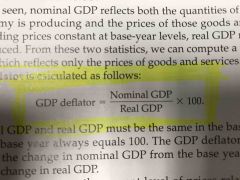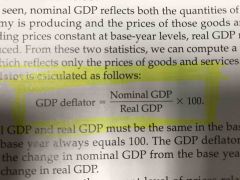![]()
![]()
![]()
Use LEFT and RIGHT arrow keys to navigate between flashcards;
Use UP and DOWN arrow keys to flip the card;
H to show hint;
A reads text to speech;
64 Cards in this Set
- Front
- Back
|
Microeconomics |
is the study of how households and firms make decisions and how they interact in markets. |
|
|
Macroeconomics |
is the study of economy-wide phenomena, including inflation, unemployment, and economic growth. |
|
|
Economists play 3 roles ? |
1. Scientists: try to explain the world 2. Policy advisors: try to improve it 3. Business/Financial consultants: try toincrease profitability |
|
|
Economist as Scientists |
Make Positive Statements which attempt to describe the world as it is. |
|
|
Economist as Policy Advisors |
Normative Statements which attempt to prescribe how the world should be |
|
|
Model |
a highly simplified representation ofa more complicated reality. |
|
|
Circular-Flow Diagram |
a visual model ofthe economy, shows how dollars flow throughmarkets among households and firms |
|
|
Factors of production |
laborlandphysical capital |
|
|
Gross Domestic Product |
The market value of all final goods and services produced within a country in a given period of time |
|
|
GDP government purchases |
All government and state and federal spending . But excludes transfer payments , such as social security or unemployment |
|
|
GDP net exports |
Exports minus imports |
|
|
GDP formula Y = |
Y= C+I +G +NX |
|
|
GDP value in dollars |
18 trillion |
|
|
GDP consumption percentage |
70% |
|
|
GDP government percentage |
18% |
|
|
Us GDP / capita |
56000 |
|
|
GDP market value |
All goods measured in dollars, its value determined by the market , if no market value it is not counted. |
|
|
GDP Final Goods |
Produced within the country , goods intendant for the end user. Intermediate goods or goods as part of an end product aren't included. |
|
|
GDP Goods and Services |
All tangible goods and in tangible services |
|
|
GDP Produced |
Includes produced goods in the us and only in the present |
|
|
GDP within country |
Good and service produced in the US whether done by Americans or foreigners |
|
|
GDP period of time |
Usually measured yearly or quarterly |
|
|
GDP Four components |
Consumption C Investment I Government G Net Exports NX GDP Y |
|
|
GDP Consumption |
Total spending by households on goods and services. Exception owning a house is measured by its rental value |
|
|
GDP investment |
Total spending on goods used to produced other goods like machines , factories , and Inventories (goods produced but not sold yet ) |
|
|
Gross Domestic Product |
The market value of all final goods and services produced within a country in a given period of time |
|
|
GDP government purchases |
All government and state and federal spending . But excludes transfer payments , such as social security or unemployment |
|
|
GDP net exports |
Exports minus imports |
|
|
GDP formula Y = |
Y= C+I +G +NX |
|
|
GDP value in dollars |
18 trillion |
|
|
GDP consumption percentage |
70% |
|
|
GDP government percentage |
18% |
|
|
Us GDP / capita |
56000 |
|
|
GDP market value |
All goods measured in dollars, its value determined by the market , if no market value it is not counted. |
|
|
GDP Final Goods |
Produced within the country , goods intendant for the end user. Intermediate goods or goods as part of an end product aren't included. |
|
|
GDP Goods and Services |
All tangible goods and in tangible services |
|
|
GDP Produced |
Includes produced goods in the us and only in the present |
|
|
GDP within country |
Good and service produced in the US whether done by Americans or foreigners |
|
|
GDP period of time |
Usually measured yearly or quarterly |
|
|
GDP Four components |
Consumption C Investment I Government G Net Exports NX GDP Y |
|
|
GDP Consumption |
Total spending by households on goods and services. Exception owning a house is measured by its rental value |
|
|
GDP investment |
Total spending on goods used to produced other goods like machines , factories , and Inventories (goods produced but not sold yet ) |
|
|
Market |
A group of buyers and sellers in a particular good or service |
|
|
Competitive market |
A market in which there are many buyers and many sellers so that each has a minor impact on the market price |
|
|
Quantity demanded |
The amount of a good that buyers are willing and able to purchase |
|
|
Law of demand |
The claim that , other things being equal , the quantity demanded of a good falls when the price of the good rises |
|
|
Demand schedule |
A table that shows the relationship between the price of a good and the quantity demanded |
|
|
Demand curve |
A graph of the relationship between the price of good and quantity of demand |
|
|
Normal good |
A good in which other things being equal , an increase in income leads to an increase in demand |
|
|
Inferior good |
A good in which , increase in income leads to decrease in demand |
|
|
Inferior good |
A good in which , increase in income leads to decrease in demand |
|
|
Substitutes |
Two good for which an increase in price leads to an increase in demand for other |
|
|
Complements |
Price of good goes up and demand for other decreases |
|
|
Quantity supplied |
Amount of good a seller cans and is willing to sell |
|
|
Law of supply |
The quantity supplied of a good rises when the price of the good rises |
|
|
Supply curve |
A graph that shows the relation between the price of a good and the quantity supplied |
|
|
Equilibrium price |
Price that balances quantity supplied and quantity demanded |
|
|
Surplus |
A situation in which quantity supplied is greater than quantity demanded |
|
|
Shortage |
A situation in which quantity demanded is greater than quantity supplied |
|
|
Nominal GDP |
Production of goods and services at current prices |
|
|
Real GDP |
Production of goods and services valued at constant prices. Or at a base year |
|
|
GDP deflator |

Back (Definition) |
|
|
GDP deflator |

Back (Definition) |
|
|
Inflation |

Back (Definition) |

